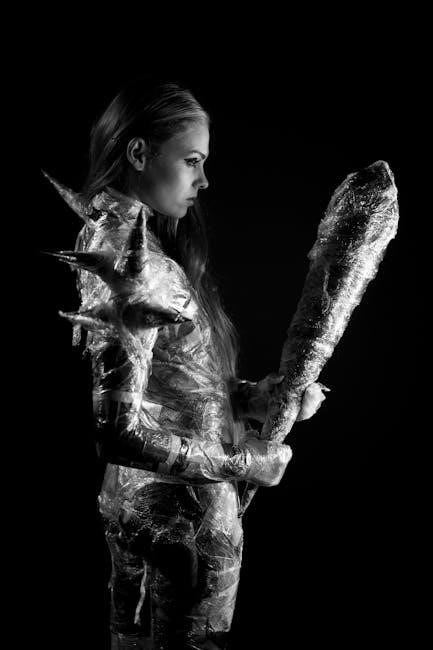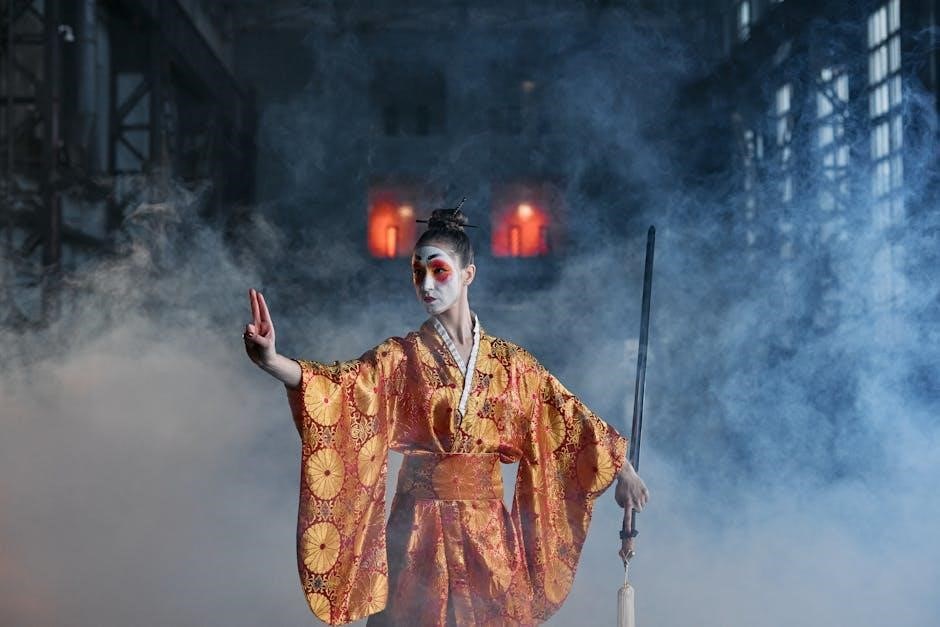maxine hong kingston woman warrior pdf
Maxine Hong Kingston’s The Woman Warrior: Memoirs of a Girlhood Among Ghosts (1976) blends myth, history, and autobiography, exploring identity, cultural heritage, and feminism through lyrical prose.
Overview of Maxine Hong Kingston’s Memoir
The Woman Warrior: Memoirs of a Girlhood Among Ghosts is a groundbreaking memoir by Maxine Hong Kingston, first published in 1976. The book blends mythology, history, and personal narrative, offering a unique perspective on the experiences of a Chinese-American woman. Set in Northern California during Kingston’s childhood in the 1940s and 1950s, the memoir explores themes of identity, cultural heritage, and feminism. Kingston weaves together stories passed down from her mother, known as “talk-stories,” with her own experiences, creating a rich tapestry of myth and reality. The memoir is divided into five chapters, each addressing different struggles, including the legacy of her disgraced aunt and her own journey toward self-discovery. Its innovative style and exploration of multicultural identity have made it a landmark work in Asian-American literature.
Historical Context of the Book
The Woman Warrior, published in 1976, reflects the cultural and social dynamics of its time. Maxine Hong Kingston wrote during a period of heightened feminist activity and growing awareness of multiculturalism in America. The memoir captures her experiences growing up as a first-generation Chinese-American in Northern California during the 1940s and 1950s, a time marked by post-war changes and shifting societal norms. Kingston’s work also coincided with the Cultural Revolution in China, influencing her exploration of identity and cultural heritage. The book’s historical context is further shaped by the immigrant experience, blending traditional Chinese storytelling with American narratives. This duality allowed Kingston to voice the struggles of Asian-American women, contributing significantly to the broader discussion of identity and feminism during the 1970s.
Significance of the Title “The Woman Warrior”

The title The Woman Warrior carries profound symbolic meaning, reflecting Maxine Hong Kingston’s exploration of female strength and resilience. The term “Warrior” evokes the legendary figure of Fa Mu Lan, a mythical Chinese heroine who embodies courage and resilience. Kingston reimagines herself and the women in her life through this lens, challenging traditional gender roles and cultural expectations. The title also signifies Kingston’s personal journey of reclaiming her voice and identity, blending myth with autobiography to create a powerful narrative. It captures the essence of her struggle to navigate dual cultural identities and to honor the silenced stories of women in her family and community. Thus, the title encapsulates themes of feminism, identity, and the enduring spirit of women across generations.

Structure and Style of the Memoir
The memoir blends mythology, history, and personal narrative, creating a unique, non-linear structure that reflects Kingston’s cultural duality and her innovative storytelling approach.
Blending of Mythology and Autobiography
In The Woman Warrior, Kingston seamlessly intertwines Chinese mythology with her personal experiences, creating a unique narrative that bridges cultural and autobiographical dimensions. By reimagining myths like that of Fa Mu Lan, she crafts a metaphorical space where personal and collective histories converge. The memoir draws heavily from “talk-stories,” oral traditions passed down by her mother, which serve as both cultural anchors and storytelling devices. Kingston’s approach challenges traditional genre boundaries, blending the fantastical with the real to explore themes of identity, cultural heritage, and gender. This fusion not only enriches the narrative but also allows Kingston to voice her own struggles as a Chinese-American woman, transforming personal memory into a universal tale of resilience and self-discovery.
Use of Non-Linear Narrative
Maxine Hong Kingston employs a non-linear narrative in The Woman Warrior, weaving together fragmented memories, myths, and personal reflections to create a layered exploration of identity. The memoir eschews chronological structure, instead moving fluidly between past and present, myth and reality. This approach mirrors Kingston’s own disjointed experience as a Chinese-American woman, grappling with cultural dislocation and personal fragmentation. By juxtaposing her childhood memories with reimagined myths, such as the story of her forgotten aunt and the legend of Fa Mu Lan, Kingston constructs a narrative that is both deeply personal and universally resonant. This non-linear style not only reflects her internal struggles but also underscores the complexity of navigating multiple cultural and emotional landscapes.
Role of “Talk-Stories” in the Narrative
“Talk-stories” are a central narrative device in The Woman Warrior, serving as a bridge between Maxine Hong Kingston’s Chinese heritage and her American upbringing. These oral tales, passed down by her mother, blend myth, history, and family lore, offering Kingston a way to connect with her cultural roots. The stories of her aunt, Fa Mu Lan, and other female figures are not just mere anecdotes but carry moral and emotional weight. Through these talk-stories, Kingston explores themes of identity, gender roles, and cultural expectations. They also function as a means of resistance, allowing her to reclaim silenced voices and challenge patriarchal norms. Ultimately, the talk-stories become a source of empowerment, helping Kingston navigate her dual identity and find her own voice.

Major Themes in “The Woman Warrior”
Identity and Cultural Heritage: Kingston explores her dual identity as a Chinese-American, navigating traditions and expectations. Feminism and Oppression: She examines the silencing of women and challenges patriarchal norms. The Immigrant Experience: The memoir reflects the struggles of cultural displacement. The Power of Silence and Voice: Kingston emphasizes the importance of storytelling to reclaim and assert identity.
Identity and Cultural Heritage
Maxine Hong Kingston’s The Woman Warrior deeply explores her struggle to reconcile her Chinese heritage with her American upbringing. Growing up in Northern California, Kingston felt torn between the traditional values of her immigrant family and the modern, assimilated world around her. Her mother’s “talk-stories” served as a bridge, blending myth and reality to connect Kingston to her ancestors. However, these stories often conflicted with her desire to fit into American culture, leading to internal conflict. Kingston’s journey of self-discovery involves questioning and reinterpreting her cultural identity, ultimately finding strength in embracing both her Chinese roots and her American experience. This duality shapes her narrative, reflecting the broader immigrant experience of balancing tradition and assimilation.
Feminism and the Oppression of Women
In The Woman Warrior, Maxine Hong Kingston addresses the oppression of women through her personal and cultural narratives. She critiques patriarchal traditions that silence and marginalize women, as seen in the story of her aunt, the “No Name Woman,” who is shamed and erased by her family and society. Kingston also reflects on her own struggles with gender roles and expectations imposed by her Chinese heritage. By reimagining female figures like Fa Mu Lan, Kingston challenges these oppressive norms, offering a feminist reinterpretation of history and culture. Her memoir becomes a powerful exploration of female resilience and the fight against systemic gender inequality, both in her family and broader society. This theme resonates deeply, making the work a landmark of feminist literature.
The Immigrant Experience in America
In The Woman Warrior, Maxine Hong Kingston explores the complexities of the immigrant experience through her personal and cultural narratives. Growing up as a first-generation Chinese-American in Northern California during the 1940s and 1950s, Kingston grapples with the dislocation of her family’s heritage in a new cultural context. The memoir reflects her feelings of isolation and the tension between her parents’ traditional values and the demands of American life. Kingston’s mother’s “talk-stories” serve as a bridge between her Chinese roots and her American upbringing, offering insights into the sacrifices and struggles of immigrants. Her journey to reconcile these dual identities highlights the resilience and adaptability required to navigate cultural dislocation, making her story a powerful representation of the immigrant experience in America. Kingston’s narrative resonates with universal themes of belonging and self-discovery.
The Power of Silence and Voice
In The Woman Warrior, Maxine Hong Kingston examines the tension between silence and voice as a means of resistance and empowerment. Kingston’s mother, through her “talk-stories,” both silences and liberates her daughter by imposing cultural expectations while sharing ancestral wisdom. The silence imposed on women in Kingston’s Chinese heritage is contrasted with the necessity of finding her own voice in America. She transforms her family’s stories into a form of personal and cultural expression, reclaiming her identity. By giving voice to her ancestors and her own experiences, Kingston challenges the patriarchal norms that suppress women’s narratives. Her memoir becomes a testament to the power of storytelling as a means to break silence and assert Agency, transcending generations and cultural boundaries. Kingston’s journey from silence to voice underscores her struggle for self-definition and cultural preservation.

Key Characters and Their Symbolism
The No Name Woman symbolizes shame and silence, while Fa Mu Lan embodies female empowerment. Kingston’s mother bridges cultural divides, imparting wisdom through storytelling.
The No Name Woman and Her Legacy
The No Name Woman, Kingston’s forgotten aunt, symbolizes the oppressive forces of tradition and silence. Her story, shrouded in shame, reflects the societal condemnation of women who defy norms. Kingston reimagines her aunt’s life, transforming her into a figure of resilience and tragedy. This reclamation challenges the erasure of women’s histories, giving voice to those silenced by cultural expectations. The No Name Woman embodies the struggles of women caught between tradition and personal agency, highlighting the lasting impact of patriarchal norms. Her legacy in Kingston’s memoir serves as a powerful critique of gender oppression and the stigma surrounding female sexuality. Kingston’s reinterpretation honors her aunt’s memory while confronting the cultural taboos that led to her exclusion.
Fa Mu Lan as a Symbol of Female Empowerment
Fa Mu Lan, a legendary Chinese warrior, becomes a symbol of female empowerment in Kingston’s memoir. Kingston reimagines Fa Mu Lan as a strong, courageous figure who embodies both physical and emotional strength. By recounting her mother’s “talk-stories” about Fa Mu Lan, Kingston challenges traditional gender roles and celebrates women’s potential for heroism. Fa Mu Lan’s journey reflects Kingston’s own struggle to reconcile her Chinese heritage with her American identity. The character represents resilience and the power of storytelling, inspiring Kingston to forge her own path. Through Fa Mu Lan, Kingston critiques the oppression of women and advocates for female agency, making her a central figure in the memoir’s exploration of identity and feminism. Fa Mu Lan’s legacy endures as a powerful symbol of transformation and empowerment.
Maxine Hong Kingston’s Mother and Her Influence
Maxine Hong Kingston’s mother plays a pivotal role in shaping her identity and storytelling voice. Through her mother’s “talk-stories,” Kingston gains insight into her Chinese heritage and the struggles of women in her family. These stories, often laced with myth and history, serve as a bridge between Kingston’s American upbringing and her ancestral roots. Her mother’s narratives, though sometimes contradictory, help Kingston navigate her cultural duality and understand the expectations placed on her as a Chinese-American woman. The mother’s influence is both nurturing and challenging, as Kingston grapples with the tension between tradition and personal aspiration. Her mother’s voice becomes a cornerstone of Kingston’s memoir, reflecting the power of maternal wisdom and the enduring impact of intergenerational storytelling.

Autobiographical Elements
The memoir reflects Kingston’s childhood in Northern California, blending personal experiences with Chinese myths and cultural traditions, exploring her identity and heritage.
Kingston’s Childhood in Northern California
Maxine Hong Kingston’s childhood in Northern California during the 1940s and 1950s is central to The Woman Warrior. Growing up in a Chinese-American family, she faced cultural tensions, feeling stifled by traditional expectations while navigating American life. Her experiences were shaped by the post-World War II era, a time of societal change. Kingston’s memoir vividly captures her struggles with identity, language, and belonging. Her mother’s “talk-stories” about Chinese myths and family history played a pivotal role in shaping her understanding of self. These stories, often laced with fantasy and cultural wisdom, helped Kingston bridge the gap between her dual heritage. Her childhood became a foundation for her exploration of identity and cultural displacement in her writing.
The Impact of Chinese Traditions on Her Upbringing
Chinese traditions profoundly shaped Maxine Hong Kingston’s upbringing, as her family adhered to cultural practices despite living in America. Her mother’s “talk-stories” about mythical figures like Fa Mu Lan and the tragic No Name Woman instilled both inspiration and conflict; These stories reflected the expectations of female silence and resilience, which Kingston struggled to reconcile with her American surroundings. The tension between honoring her heritage and navigating a foreign culture created a sense of duality in her identity. Chinese values emphasized family honor and gender roles, influencing her early understanding of self and her place in the world. This cultural legacy became a central theme in her writing, as she sought to bridge her dual identity. Kingston’s experiences highlight the challenges of preserving traditions in a new world.

Her Struggle with Cultural Identity
Maxine Hong Kingston’s memoir vividly portrays her struggle with cultural identity as a first-generation Chinese American. Growing up in Northern California, she grappled with the duality of her heritage, caught between the traditional values of her Chinese family and the dominant American culture. This cultural dislocation left her feeling fragmented, as she navigated the expectations of both worlds. Kingston’s writing becomes a means of reconciling these opposing forces, as she seeks to define herself amidst the tension. Her experiences of alienation and self-discovery reflect the broader challenges faced by immigrant communities. Through her narrative, she explores themes of belonging, cultural expectations, and the quest for a cohesive identity, ultimately finding empowerment in her unique voice.

Literary Techniques and Devices
Kingston employs metaphors, imagery, and non-linear storytelling in The Woman Warrior. She reimagines myths and uses “ghosts” to symbolize cultural dislocation and identity struggles, blending cultural narratives with personal experiences to create a lyrical exploration of self.
Use of Metaphor and Imagery

Maxine Hong Kingston employs metaphors and vivid imagery to explore themes of identity, cultural dislocation, and personal struggle. The recurring metaphor of “ghosts” symbolizes her feelings of alienation and the haunting presence of her ancestral past. Imagery-rich descriptions of her childhood in Northern California and the myths of her Chinese heritage create a layered narrative. Kingston uses the metaphor of the “No Name Woman” to represent silenced female voices and the “Fa Mu Lan” legend to embody female empowerment. These metaphors and images weave together personal and cultural histories, allowing Kingston to forge a sense of self amidst conflicting identities. Her lyrical prose brings these elements to life, enriching the memoir’s emotional and thematic depth.
The Role of Ghosts in the Narrative
Ghosts play a central role in Maxine Hong Kingston’s The Woman Warrior, symbolizing her cultural dislocation and emotional conflicts. These spectral figures represent both her ancestors and the intangible aspects of her Chinese heritage. Kingston frequently refers to herself growing up “among ghosts,” highlighting her feelings of alienation in America. The ghosts also embody the silenced stories of her female ancestors, particularly her “No Name Woman” aunt, whose legacy haunts her. By weaving these ghostly narratives into her memoir, Kingston bridges the gap between her Chinese roots and her American identity. The ghosts serve as a metaphor for her internal struggle to reconcile cultural traditions with personal identity, creating a haunting yet powerful backdrop for her journey of self-discovery.
Reimagining Historical and Mythological Figures
Maxine Hong Kingston reimagines historical and mythological figures in The Woman Warrior to challenge traditional narratives and reclaim female agency. A prime example is her reinterpretation of Fa Mu Lan, a legendary Chinese warrior. Kingston transforms Fa Mu Lan into a symbol of female empowerment, envisioning herself as the warrior to assert her own strength and identity. Similarly, she recontextualizes the story of her “No Name Woman” aunt, giving voice to a figure silenced by shame and cultural oppression. By reimagining these figures, Kingston not only honors her cultural heritage but also subverts patriarchal norms, creating a space for women’s stories to be told and valued. This reimagining serves as a powerful tool for self-discovery and cultural critique, blending myth with personal experience.

Reception and Impact of the Book
The Woman Warrior received widespread acclaim, winning the National Book Critics Circle Award. It is celebrated for its lyrical prose and exploration of cultural tensions, significantly influencing Asian-American literature.
Critical Acclaim and Awards
The Woman Warrior garnered significant critical acclaim upon its release in 1976. It won the National Book Critics Circle Award for Nonfiction, solidifying its place in contemporary literature. Critics praised Kingston’s lyrical prose, innovative blending of myth and autobiography, and her exploration of cultural identity. The book was celebrated for its unique narrative structure and its ability to bridge personal and cultural histories. Its success marked a turning point in Asian-American literature, earning Kingston widespread recognition. The memoir’s ability to resonate with diverse audiences contributed to its enduring popularity and critical praise, making it a landmark work in feminist and multicultural literature. Its influence continues to be felt in literary circles today.
Controversies and Criticisms
The Woman Warrior faced criticism, particularly from some Chinese-American communities, for its portrayal of cultural practices and family secrets. Certain critics accused Kingston of sensationalizing or misrepresenting Chinese traditions, arguing that her depiction of female oppression and cultural rituals was overly harsh. Others questioned the blending of fact and fiction, challenging the memoir’s authenticity. These criticisms sparked debates about cultural authenticity and the role of the writer in representing their heritage. Despite these controversies, the book remains a significant work in feminist and multicultural literature, acknowledged for its bold narrative style and emotional depth. The discussions it provoked highlight the complexities of cultural representation in autobiographical writing.
Influence on Asian-American Literature
The Woman Warrior has profoundly influenced Asian-American literature, paving the way for authors like Amy Tan and Gish Jen. Kingston’s innovative blend of memoir, mythology, and cultural critique inspired a generation to explore their dual identities. Her work challenged traditional narratives, giving voice to the experiences of immigrant women and their daughters. By intertwining personal and cultural histories, Kingston created a model for storytelling that resonates with diverse audiences. Her influence extends beyond literature, fostering dialogue on multiculturalism and identity in broader cultural contexts. The memoir’s success marked a turning point, legitimizing Asian-American voices and stories within the literary canon, ensuring its lasting impact on contemporary literature.
“The Woman Warrior” is acclaimed for blending memoir, mythology, and fiction, exploring identity and cultural heritage. It earned the National Book Critics Circle Award, establishing Kingston as a major literary voice and inspiring future generations with its lyrical prose and deep emotional resonance.
Legacy of “The Woman Warrior” in Contemporary Literature
Maxine Hong Kingston’s The Woman Warrior has left an indelible mark on contemporary literature, particularly in Asian-American narratives. By weaving together personal stories, cultural myths, and historical context, Kingston created a groundbreaking work that challenged traditional memoir structures. The book’s innovative blend of genres and its exploration of identity, feminism, and multiculturalism have inspired countless authors, including prominent figures like Amy Tan and Gish Jen. Its influence extends beyond literature, fostering a deeper understanding of the immigrant experience and the struggles of women in diverse cultural contexts. Today, The Woman Warrior remains a pivotal text in feminist and multicultural studies, continuing to resonate with readers worldwide.
Maxine Hong Kingston’s Contribution to Feminist Literature
Maxine Hong Kingston’s The Woman Warrior stands as a landmark in feminist literature, offering a powerful exploration of women’s experiences, cultural oppression, and personal empowerment. By reimagining the lives of female figures like the No Name Woman and Fa Mu Lan, Kingston challenges patriarchal narratives and gives voice to silenced women. Her work not only critiques gender roles within Chinese culture but also resonates universally, addressing the struggles of women across cultures. Kingston’s lyrical prose and innovative blending of myth and autobiography have inspired countless writers, making her a pioneer in feminist storytelling. Her contribution lies in her ability to merge the personal with the political, creating a work that remains foundational to feminist and multicultural literature.


